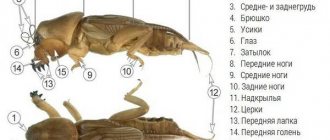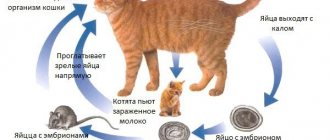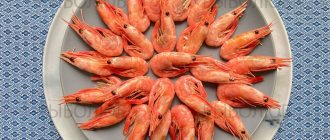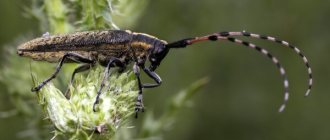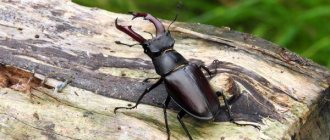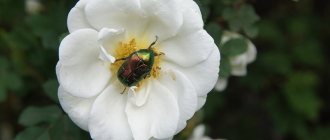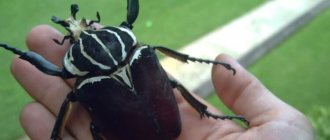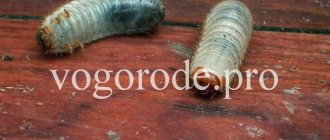Longhorn beetles or woodcutter beetles are a large family of insects, including about 600 species in Russia alone. The total number of longhorned beetles in the world is about 26,000 species. The relatively small number of woodcutter beetles in Russia is explained by the general thermophilic nature of insects.
In our conditions, the most resilient survive. The number of species is not constant; interspecific matings and the emergence of new hybrid species are possible.
Appearance of longhorned beetles
A distinctive feature of the family is considered to be luxurious long segmented and movable mustaches, in some cases significantly exceeding the length of the body.
The shell is durable; thin, relatively small, but functional wings are hidden under the hard elytra.
The beetles themselves are exceptionally beautiful and graceful. Every aspiring etymologist is required to collect a collection of the largest and brightest representatives of these coleopterans. The collection usually includes a huge beetle - titanium, alpine longhorned beetle, Ussuri giant and steppe black longhorned beetle. Even the six-centimeter black longhorned beetle, often found in the Rostov and Stavropol regions, makes the most indelible impression. These beetles are nocturnal and, unlike other insects, prefer space. That is, the path of the longhorned beetle through your bedroom will not run along the wall, but right in the center, without being at all embarrassed by the illuminated places. For an unprepared person, an encounter with a huge beetle that clearly believes itself to be the owner of the room can be a shocking encounter.
Behavior of beetles in nature
An adult beetle poses no danger to humans. Despite its terrifying jaws, the beetle has a quiet and docile disposition, poses with pleasure, does not hide or run away, is not afraid to sit on the palm, and does not make any attempts to bite or harm a person. Males are much larger than females, have longer mustaches and a slender, elongated body. Females are distinguished by their rounded shape and not too long mustache - much shorter than that of males of the same species.
The mustache is an important tactile organ. The beetle uses them to probe its surroundings and detect changes in temperature and humidity. If a beetle is frightened, it folds its whiskers parallel to its body to appear less noticeable. In the normal state, the whiskers are extended upward and forward and help the beetle navigate in space.
What does the longhorned beetle eat?
The food of an adult insect is succulent plants, flowers, pollen, and the tender bark of young plants. Adult beetles are rare gourmets, extremely harmless and cute creatures.
The pests are the voracious larvae of the longhorned beetle. The larva has a lifespan of 1-2 years, but under certain conditions it can exist in the woody area for several decades, in some cases up to 50 years. In just a few months, a colony of longhorned beetle larvae can completely destroy a wooden residential building, along with floors and furniture, making it uninhabitable. To be fair, we note that not all longhorned beetles feed on wood. Some larvae are able to feed on soil and humus, herbaceous plants, and roots.
Many species of longhorned beetles can fly. Not always, only during the mating period. Flights expand their habitat and provide the opportunity for interspecific crossing, which is common among longhorned beetles. The flight range is usually not too long, from several tens of meters to a couple of kilometers.
Why do beetles make such loud noises?
An additional interesting feature of longhorned beetles can be considered a peculiar crunchy creaking sound, which is produced when the hind legs rub against the hard wing covers and the rib on the abdomen. The sounds are quite loud, quite capable of turning a wooden house into a Silent Hill playground or another standard horror movie for a city dweller. Rural residents consider the sweet creaking of the house a cozy attribute of a quiet life in the wilderness.
Grating sounds have a functional purpose - they scare rodents and small predators, and during the mating season, a loud creaking noise allows the beetles to find suitable partners.
Scented beetle / Calosoma sycophanta
The ground beetle family is represented by the beetle, which received its specific name due to its unusual color. Emits a sharp, unpleasant odor in moments of danger.
It has a characteristic greenish-blue color with a bright golden tint. They grow up to 35 mm in length. The beauty lives from 2 to 5 years. Leads a daily lifestyle. This is a dangerous predator that eats caterpillars and silkworms. Over the summer it can eat up to 300 caterpillars.
Settled throughout the south of Europe, Western Asia, and the countries of Southeast Asia. It is protected in many countries. The number directly depends on the number of caterpillars.
11
Life cycle of longhorned beetles
The life cycle of most species of longhorned beetles takes 1-2 years. The female beetle lays several hundred, up to 400 eggs in a suitable place - a moistened grass substrate, in soft bark, having previously made a hole, in a gap between boards or in a defect in a log or board. The female can lay eggs even in a tiny piece of bark, in the hope that in the future the larva will take care of itself by gnawing through hard wood. Some species lay their eggs one at a time in the bark, gnawing out a separate cavity for each egg.
barbel larva
The main condition for the successful development of larvae from eggs is warmth and humidity. The larva is a white worm without legs, but with tenacious outgrowths along the edges of the body and with a dark head, armed with powerful jaws capable of gnawing through any wood. Different species of longhorned beetles prefer different types of wood, but in general most beetles are capable of feeding on any tree. Since there are many larvae, one clutch can immediately cause serious harm.
With the onset of cold weather, the larva goes deep into the tree species and waits out unfavorable conditions. With warming and the return of full humidity, the larva returns to the outer layers of the wood, successfully pupates, passes the adult stage, gnaws its way to the surface and a new adult beetle is born.
barbel larva
The viability of the larvae is very high. Scientists consider these beetles to be the same age as dinosaurs, which have quite successfully survived in all their diversity to the present day. Under unfavorable conditions, the larvae seem to be preserved inside the wood and can remain viable for decades. If there is insufficient nutrition, the underfed larvae produce small beetles after pupation.
barbel pupa
After birth, an adult beetle lives only a few months, until about mid-summer. During this time, the beetles manage to migrate, find suitable partners, and arrange clutches.
Interesting Facts
- Despite its powerful jaws, capable of chewing through a pencil, the beetle's bite is not dangerous to humans. He is not capable of causing him serious harm.
- An adult longhorned beetle, even a giant one, eats very little. Sometimes he lives only thanks to the reserves that he accumulated as a larva. Females feed more than males to ensure normal egg maturation.
- In her territory, the female most often has no rivals. She secretes a special pheromone that attracts males and repels other females.
- A grown beetle lives for one summer season, a maximum of 2-3 months, and the larva is much longer, for years, in some species up to 10 years.
- Some futurists predict that in the future we will eat wood. If you study and use the digestive system of the longhorned beetle, it is quite possible to do this. Its intestines are equipped with special bacteria that process cellulose into easily digestible carbohydrates. Periodically, the larvae process these bacteria, obtaining additional nutrients from them. Waste-free production.
- It may seem strange, but not butterflies and bees, but the longhorned beetle is inextricably linked with flowering plants. They spend most of their short lives on flowers. And because of their size, they pollinate a large surface. Thanks to his taste preferences, some plants have been preserved and survived in nature.
The largest barbels in the world
The largest representatives of longhorned beetles live in South America. The titanium beetle reaches a length of 17 cm, excluding the length of the mustache. The large-toothed staghorn beetle or stag beetle can be more than 18 cm. The largest longhorned beetle in Russia, the relict Ussuri beetle, reaches only 11 cm, but this is also quite a lot.
relict barbel
The color of beetles can be any, depending on their habitat. Due to their significant size, adult insects may not be too afraid of becoming food for birds. Beetles scare away small predators with a sharp and loud squeak.
Features
The woodcutter beetle has a number of characteristic features that distinguish this type of pest from many others. These include:
- Long mustache. The longhorned beetle has prominent whiskers that are 2-5 times longer than the insect itself.
- Slender and elongated body. The length of the body varies from 3 to 60 mm.
- Wings. Some species of woodcutter beetles can fly.
- Hair.
The role of longhorned beetles in the wild
Within the ecosystem, the role of prolific and active longhorned beetles is significant. Larvae and adults are excellent food for birds and small mammals.
Active and voracious larvae are involved in the process of recycling old and diseased trees and windbreaks. It’s not for nothing that the beetle is called a lumberjack. Scientists are exploring the connection between the life of lumberjack beetles and the spread of mycelia - myceliums inside stumps and fallen trees. The essence of the problem is this: wood alone is not enough to feed the larvae and ensure normal ripening. Protein-rich myceliums are a good help in feeding beetle larvae. But on the other hand, it is much easier for the mycelium to penetrate loose and oxygenated wood that is already infected with larvae. The interesting symbiosis of fungi and larvae is the topic of many studies in the field of ecology.
With the help of beetles, old stumps are quickly transformed into a nutrient substrate on which grass and young plants can grow. Adult beetles and adults play an important role in plant pollination because they feed on pollen.
The most dangerous barbel
The black house beetle woodcutter
is a dark or black house beetle that has chosen residential wooden houses as its main habitat. The beetle itself is very large, has a body up to 8 cm or up to 20 cm if you count the antennae. The larvae are relatively small, about 3 cm long and about 3-5 mm in diameter. The beetle settles in window frames, ceilings, partitions, and furniture.
damage by longhorned brownie beetle
The black house beetle develops only in treated coniferous, mainly spruce, pine and larch wood, for example, in beams, posts, etc. Severe damage
wood in buildings and structures is observed primarily in areas with high air humidity (for example, seaside, coastal areas), especially where the air temperature is quite high.
house beetle longhorned beetle
The flight of beetles begins in mid-June and lasts until August, occurring on hot days, especially in the afternoon and afternoon. They fly over relatively short distances. The female lives only about 25 days and lays eggs for only 12 days, immediately after mating. Oviposition is influenced by light intensity, terpene odor and irritation of the touching substrate. The female lays her eggs in wood crevices to a depth of 20-30 mm. In 2-8 sessions, the female can lay an average of 200, at most 420 eggs, from which larvae emerge after 1-3 weeks. Soon they begin to gnaw through passages, oval in cross-section, passing only through layers of spring wood and clogged with fine drill flour and excrement. Gradually the passages expand to 12 mm in diameter. The surface layer of wood remains intact and can be as thin as paper. Gradually, the sapwood is completely corroded, while the core usually remains intact. Adult larvae prepare a flight hole for future beetles, then expand the passage and create a pupal cradle, which is lined with shavings on one side and clogged with drill flour on the other. The larva goes through the prepupal stage, which lasts 1-2 weeks. The pupal stage itself lasts 2-4 weeks. When the young beetle's body becomes stronger, it leaves the wood through an oval hole. All development lasts 2-10 years, most often 3-6 years and depends on the quality of food, temperature and humidity of the wood.
The black house lumberjack is common
in Europe, Siberia, the Caucasus, Transcaucasia, Iran, Iraq, Syria, Asia Minor and China. In the south it is found as far as northern Africa; it has also been introduced into southern Africa and North America. The black house lumberjack is a dangerous technical pest of wood in buildings and structures.
Ladybug / Coccinella septempunctata
Our list opens with the most common type of ladybugs. The elytra are colored red or orange with seven black dots.
The green beetle spread from the Far East to the Iberian Peninsula, in North Africa. In Russia it is found in the steppe zone, in gardens, and on the southern slopes of mountains covered with forests. Other species have spread throughout the planet except Antarctica.
This is a predator that eats aphids, whiteflies, and some types of scale insects. They were specifically brought to North America to reduce the aphid population. In the Northern Hemisphere, it displaces other species, as it is more distinguished by aggressive behavior.
2
How to understand that a building is infested with larvae
If small piles of wood dust appear on or near a wooden wall, this is a sure sign of the presence of a woodworm. Don't wait for new signs, such as a roof collapse. Take action. Unfortunately, the larva holds all the good cards - she is safe, she has a lot of good food, if she does not like the conditions, she can go deeper and spend ten years there. There are no chemicals that penetrate to a significant depth of wood. Accordingly, the risk of infection will remain.
drill flour
Oddly enough, many woodborers adore hardwood - oak, mahogany, ash, walnut. Such furniture and interior panels, stairs, are very expensive. You can understand that precious wood needs to be saved by the characteristic dull knock. Well-impregnated hardwood has a ringing sound when struck. A dull sound means the presence of winding passages eaten by beetle larvae. Some cabinetmakers have learned not only to save things eaten away by bugs, but also to give restored surfaces with cavities filled with synthetic resins a special beauty. Such pleasure costs quite a lot of money even for antiques, but the result is amazing.
Relatively soft wood - spruce, pine, birch - suffers more from the bug. Determining the presence of a bug by sound is more difficult. Tap the wood not with your knuckles, but with the back of the hammer. If the surface sags and the sound is completely dull, things are bad. Heavily eaten wood can be pierced even with a good screwdriver. The affected fragments must be immediately removed and replaced, having previously been treated against longhorned beetle larvae.
Sacred Scarab / Scarabaeus sacer
In Ancient Egypt, if a scarab was encountered on the way of an army, it turned back. The most revered symbol in the mythology of Ancient Egypt.
Today, the habitat is limited to southern Europe, North Africa, and the steppe regions of Eastern Europe. It is found in Kazakhstan, Turkey, and on the islands of the Mediterranean Sea. The body color is black, and with age, adult specimens become shiny.
One of the features is the ability to roll manure balls. In many European countries, the scarab is listed in the Red Book.
9
Is it possible to get rid of barbel larvae?
It is quite difficult, almost impossible, to completely and reliably get rid of larvae. But making the larva die is quite possible. The treatment is carried out with an extremely dangerous product. The basis of toxic substances is phosphine. Also, an innovation on the Russian market, XILIX GEL, allows us to provide a 10-year guarantee on processed objects.
Read more about the phosphine fumigation process here.
Staying inside the house during treatment without a gas mask is completely excluded. After a few hours, you can ventilate the premises and perform external treatment of the walls. Phosphine-based toxic substances are highly volatile and dissipate fairly quickly.
This slideshow requires JavaScript.
Marbled beetle / Polyphylla fullo
A large representative of coleopteran insects of the Khrushchia subfamily. Adults grow up to 4 cm.
It is easy to recognize by its characteristic marble pattern. There are white spots of different shapes on the dark body. Because of this original coloring they received their specific name. At the front of the head are two large antennae.
A large beetle has spread throughout southern Europe. It feeds on leaves, flowers of fruit and agricultural plants. The larva happily eats plant roots.
Prevention and protection
When building a wooden house, bathhouse, finishing, roofing, rafters, wooden floors, make sure of the quality of the wooden materials. They should not show characteristic signs of infestation with woodworm larvae. All bark, bast, must be completely cut off, without the slightest trace. The porous structure of the bark and bast is an ideal habitat for larvae, which will make their way further and at a good speed. Even a small piece of bark, left inadvertently, can become a source of infection for an entire house. Burn the removed bark; do not leave it for the winter.
injection with insecticides
Fireflies / Lampyridae
They may not be the most beautiful, but they have a feature that, in the opinion of most-beauty, makes them stand out in a huge family. These bugs glow in the dark.
They have special luminous organs - lanterns. Glow acts as a means of communication between individuals. Signals are divided into groups - protective, attractive, signals of agreement and refusal. The glow itself is a complex process of several chemical compounds.
The firefly family has more than 2,000 species. They settled on all continents except Antarctica. In Japan, there is even a special holiday in honor of these insects - Hotarugari.
10
Pay attention to wood processing
Defects in boards and beams, the presence of nicks, cracks, and rot are convenient places for beetles to lay. Gaps between logs, beams, and tow made from natural materials are a direct invitation to woodworms into the house. Use mineral wool, insect repellent, seal all cracks until completely smooth. The wood must be treated with a special impregnation, and then covered with drying oil and varnish or a liquid coating with a plasticization effect.
When using varnishes and drying oils, the outer coating of wood must be renewed annually. Otherwise, insects will destroy the house very quickly. In cold climates with long winters, the activity of woodcutter beetles is not too great. Houses can stand for hundreds of years and remain strong. In humid and warm climates, beetle larvae pose a serious danger and very quickly destroy unprotected tree structures.
Folk methods of struggle
Based on folk recipes, it is possible to prepare effective means of combating woodcutter beetles. For example:
- Take a 2.5% solution of sodium fluoride (250 g) and dilute it in 10 liters of water. Wooden structures are treated using a spray bottle, using 200 ml of product per 1 square meter.
- The product is prepared from identical parts of resin, black carbolic acid and naphthalene. The product is applied to the wood using a brush.
- It is permissible to treat wooden furniture with hot drying oil, but this method will deprive it of its attractiveness.
- Kerosene and turpentine are mixed in a ratio of 1:3. The tree is treated with Vaseline, and the prepared liquid is poured into the beetle passages. After this, the entrances are sealed with paraffin.
Zlatki
Gold beetles (Buprestidae) are very beautiful. Golden, green, yellow, with multi-colored spots. All borers have a very durable shell. They feed on leaves or thin bark of plants, causing significant damage to plants. In sunny weather, beetles quickly run from one place to another along tree trunks heated by the sun; No wonder they are called “children of the sun.”
Chrysanthemum on a buttercup flower
Twirly
This family of small-sized water beetles (on average about 6 mm) includes several hundred species, mostly inhabiting tropical waters, but such beetles are also found in the northern regions, in particular in fresh water bodies near the Black Sea coast, in Sweden, Norway, Spain. And a couple of dozen species live in Russia.
Such beetles, like the previous ones, belong to the suborder of carnivores and feed on small aquatic life, not only alive, but also dead. Their way of digesting food is very interesting, because the main processes occur not inside, but outside their body. The spinners inject enzymes into their prey, which dissolves it, and then only suck it up.
The body shape of such creatures is oval, convex; The color is predominantly black and shiny. On the surface of the water they move energetically, quickly, stay in groups, constantly describing circles and dancing in circles without rest, for which the beetles got their name. And only sensing a threat, they dive into the water.
In addition, they can fly, as they are naturally endowed with membranous, well-developed wings. For their tirelessness, these waterfowl insects have been awarded the title of the fastest swimmers among their own kind. The largest species of such organisms are found in East Asia; their representatives can grow to a size of two or more centimeters.
Lamellaridae
Lamellar beetles (Scarabaeidae), like many other beetles, are diversely represented in the tropics. 435 species of scarabaeids have been identified in the fauna of Russia. The largest tropical species is the African goliath, which was previously considered the largest among beetles. But later, a giant creaking creature larger than a goliath was discovered in the tropical forests of America.
Tropical bronze
Dead eaters
The orderlies of our fields and forests are carrion eaters (Silphidae). A large number of these beetles accumulate near the corpses of dead animals, dig under the corpse, scooping out the soil from under it. Thus, they lower the corpse into the ground, where they then eat it together with their larvae. One of the few beetles that care for their offspring: adults feed the larvae, although they are capable of feeding on their own.
Gravedigger, or black-whiskered gravedigger (lat. Nicrophorus vespilloides)
Narynniki
Blister beetles (Meloidae) have bright, often spotted warning colors. The blood of these beetles contains cantharidin, a substance that causes deep ulcers on the skin.
Epicauta hirticornis
T-shirt scarred
Bark beetles
Previously, bark beetles were considered a separate subfamily, but now they are classified as weevils. Small beetles, pests of tree species. Adult beetles can make “ticking” sounds by tapping their heads against the walls of tunnels they have gnawed into wood - they can often be heard in old wooden houses at night. A number of species have a device for removing debris that interferes with movement along the passages - a depression in the elytra, which is called... a wheelbarrow! Yes, yes, friends, these are the only bugs with cars.
Great spruce beetle (lat. Dendroctonus micans)
What harm can they do?
Insects pose a danger to garden crops, garden and ornamental plants. Having settled in a summer cottage, they begin to actively devour any types of seedlings, garden shrubs, vegetables in the beds, and even corn and sunflowers. Insects can cause great damage to grapes.
Pests indiscriminately destroy all crops encountered in their path. The inhabitants of 2-3 earthen burrows are capable of destroying vegetation on an area of 5-7 sq.m. in a short period of time.
Sensing danger from a person, the crayfish can bite him. These bites do not pose a danger to people, but are extremely unpleasant.

